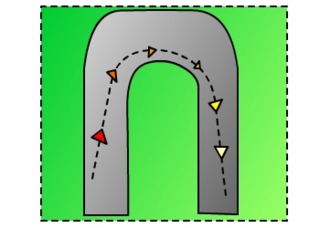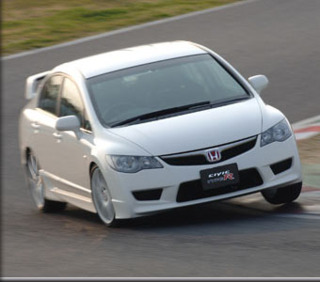Overview
One of the most important aspects in a racing game is cornering. Some consider it an art, others a plain technique; the truth is that in order to be a good driver one must learn to manage turns and corners. Anyone can drive fast in a straight line, but only a true pro can keep speed through a turn.
 Ideal line for a hairpin turn.
Ideal line for a hairpin turn.Types of Cornering
There are many different ways to take a turn correctly, some for showoff and other for maximum gain of speed. The purpose of this article is to expose those techniques commonly found in video games.
 Grip turn. Notice the lack of skidding.
Grip turn. Notice the lack of skidding.Grip turn:
This is probably the easiest and by far most common technique to deal with a corner. The driver approaches the corner while braking, then turns in a way that follows the best possible line (by grabbing the apex of the turn), point after which the throttle is reopened to exit the turn as fast and wide as possible (to minimize lose of speed due to friction angle). This type of turn is most commonly found in racing simulators and circuit racing. There is no presence of drifting during a grip turn. Drift turn. Notice that the tires don´t point in the direction of the corner.
Drift turn. Notice that the tires don´t point in the direction of the corner.Drift turn:
This type of cornering technique, which is the most aesthetically spectacular of them all, consists in increasing the entry speed and, to avoid crashing into a wall or leaving the circuit, the driver violently turns the car in the same direction as the corner, then does it gently in the opposite direction. The result is a corner in which the rear end of the car is looser then the front end, the tires skid through the pavement instead of firmly holding into it and, visually, it seems that the car is going sideways. A drift is easier to perform in a car with rear-wheel drive, and it is easily held if the car has a great deal of power. Drifting produces tire squeal and smoke, which is why it is considered as a showoff; technically, it is inferior to grip turning. It is considered an intentional oversteer, which in traditional racing is thought as something undesirable. Boost turn in Mario Kart. Notice both the drift angle and the boost ready to be used.Boost turn:
Boost turn in Mario Kart. Notice both the drift angle and the boost ready to be used.Boost turn:
This is a type of cornering technique which can only be performed in special kinds of vehicles, and in certain games. The driver takes the corner, normally using a drift (although a grip turn can also be considered) and takes the vehicle through a line that allows the nose of the vehicle to point straight to the exit of the turn once most of the corner is cleared. Then, whether it be intentionally or not, the vehicle is helped to exit the turn quickly with a boost of some sort. This helps it to align quickly by minimizing the centrifugal force, thus making possible for the driver to enter/exit corners faster. In the Mario Kart series, holding a drift for a long time gives the player a small boost intended to help him exit a corner, or in Mario Kart: Super Circuit, just by straightening the kart correctly the player is rewarded with a boost at the exit. In the F-Zero series, the player must manually release the boost to stop the machine from skidding sideways and goig into a wall. Boost turns can also be performed in "real" vehicles and more sim-oriented type of racing, by two different ways. The easier way, which can be used in the Need For Speed series, is taking the turn as fast as possible, that using the NOS to balance the car and perform the boost turn. The second, and much harder way to perform this in a car is having a vehicle equipped with a turbo(the bigger the better). The driver must be skilled enough to open the gas moments before he would do in a regular car (to anticipate turbo lag) and once the car is ready to exit the turn, the turbo will deliver instantaneous power to the engine, generating a small boost.- Throttle toggle turn: this type of turn is relatively simple to perform, yet it can be very useful when driving heavy vehicles or vehicles with poor grip. What the driver does is initiate a normal grip turn, then, as the vehicles weight or poor grip begin to act by making it skid to the outer part of the track, the driver opens and closes the accelerator sequentially to get small amounts of forward motion and correct the turning angle progressively. This technique can also be used to correct turns when the driver is about to lose control.
Log in to comment